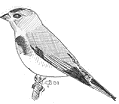|
Back to
Newsletter
Systematic list -
Mediterranean Gull to Great Black-backed Gull.
Kittiwake to Rock
Pigeon.
Stock Pigeon to Sand
Martin.
Swallow to Wren.
Hedge Accentor to
Blackbird.
Fieldfare to Garden
Warbler.
Blackcap to Coal Tit.
Blue Tit to Chaffinch.
Greenfinch to Reed Bunting (below).
Part 1, Red-throated Diver to Great Skua,
was
published in the June 2002 Newsletter.
European Greenfinch
Carduelis chloris
Resident
Peak count in 1st. winter period :- 7 February 15th.
Peak count in 2nd. passage period :- c.50 between 0730 and 0830 hrs. October 12th.
Peak count in 2nd. winter period :- 19 November 29th.
[ There has been a marked increase in the numbers of Greenfinch in the general area with a minimum of 27 singing males in the gardens along Greenbank Road, West Kirby in April. This was mirrored in late summer by c.100 birds along Newhall Farm Lane, across Hoylake Langfields, with at least 80 juveniles among them.]
European Goldfinch
C. carduelis
Resident
Peak count 1st. winter period :- 11 February 27th.
Peak count 2nd. passage period :- 59 between 0800 and 0900 hrs. October 21st.
Peak count 2nd. winter period :- 34 November 21st.
[ After c.5 years of increase, local Goldfinch numbers appear to have reached a plateau, with Greenfinch taking the first spot as the commonest finch in the general area. Yet again, another species of which good numbers were to be found on Hoylake Langfields during the early part of the year.]
Spruce Siskin
C. spinus
Passage visitor
Flocks of 10 - 20 April 5th., September 17th., October 11th., 12th. 21st. and 22nd. 50 on October 4th. was the peak count for the year. All birds were noted passing over in flight.
[Siskin are under-recorded on site as they tend to pass through on spring migration after the wardening has finished, and at the time of autumn passage we are too engrossed in the returning waders.]

Common Linnet
C. cannabina
Resident
Peak count 1st. winter period :- 12 February 27th.
Peak count 2nd. passage period :- 94 between 0800 and 0900hrs. October 21st.
Peak count 2nd. winter period :- 57 December 7th.
Present throughout with up to 6 pairs breeding on the golfcourse and feeding on the saltmarsh with a post-breeding flock of 61 August 11th..
[ Another species that was commoner on Hoylake Langfields during the first part of the year. Numbers were 83% down on the same period of the previous year on the shore.]
Twite
C. flavirostris
Scarce winter visitor
January 2nd, 15th, 30th., February 9th., October 7th., 11th. All the above sightings were of singles. The only multiple sighting was of 8 October 17th.
[ Although Twite are scarce visitors to the wardening area the position might not be as bleak as figures suggest. There is a good chance that birds may be missed in the very mobile wintering flock of Linnet found on the shore. The sightings at the start of the year were probably all of the same bird.]
Lesser Redpoll
C. cabaret
Scarce passage
7 April 19th. and 16 October 4th. were the only records for the year and both were in flight.
[ Although Redpoll are probably annual they tend to be recorded flying over and those birds that are seen on site are only found early in the morning. Yet another 'armchair tick' for your British list as Lesser Redpoll, the taxon that breeds in Britain and in Central Europe, has been split from the others which are now referred to as Mealy Redpoll C. flammea and are a county rarity.]
Common Crossbill
Loxia curvirostra
Vagrant
2 in flight over the site July 14th.
[There was a very small 'invasion' of Crossbill around the mouth of the Dee during July with up to 4 birds present at Thurstaton earlier in the month and 7 over Point of Air the day following the above record. Another 4 birds were found on the opposite side of the golfcourse on 1st. October. This is another species group which is being investigated in order to try and sort out the taxonomic position of the different forms.
Some of the more extreme suggestions have claimed up to 10 separate species within Common Crossbill, mainly from North America.]
Snow Bunting
Plectrophenax nivalis
Winter visitor
1 ( m. ) January 23rd. in flight over the shore.
[ Another poor year with only a single record. The bird at the start of the year may have been the same individual as last years single record, which makes it even worse, one bird in two years ! ]
Reed Bunting
Emberiza schoeniclus
Resident
Peak count 1st. winter period :- 17 March 9th.
Peak count 2nd. winter period :- 34 October 7th.
Birds were present throughout with up to 4 pair breeding in the Phragmites marsh.
[Reed Bunting are a regular breeding bird on site and by the prevalence of juveniles in July
and August, had a good breeding season. There are normally three peaks observable during the year, the two winter ones and a late summer / early autumn one caused by juveniles, dispersing birds and migrants. This year the numbers remained fairly constant, after the early spring return from Hoylake Langfields, and so distinct passage periods were not noticeable.]
Escapes seen during
2001:
Chestnut-breasted Shelduck, Ruddy Shelduck, Barbary Falcon, Hybrid Falcon, Cockatiel
and Yellow-fronted Canary.
Back to newsletter.
Mediterranean
Gull to Great Black-backed Gull.
Kittiwake to Rock
Pigeon.
Stock Pigeon to Sand
Martin.
Swallow to Wren.
Hedge Accentor to
Blackbird.
Fieldfare to Garden
Warbler.
Blackcap to Coal Tit.
Blue Tit to Chaffinch.
Part 1, Red-throated Diver to Great Skua,
was
published in the June 2002 Newsletter.
|
